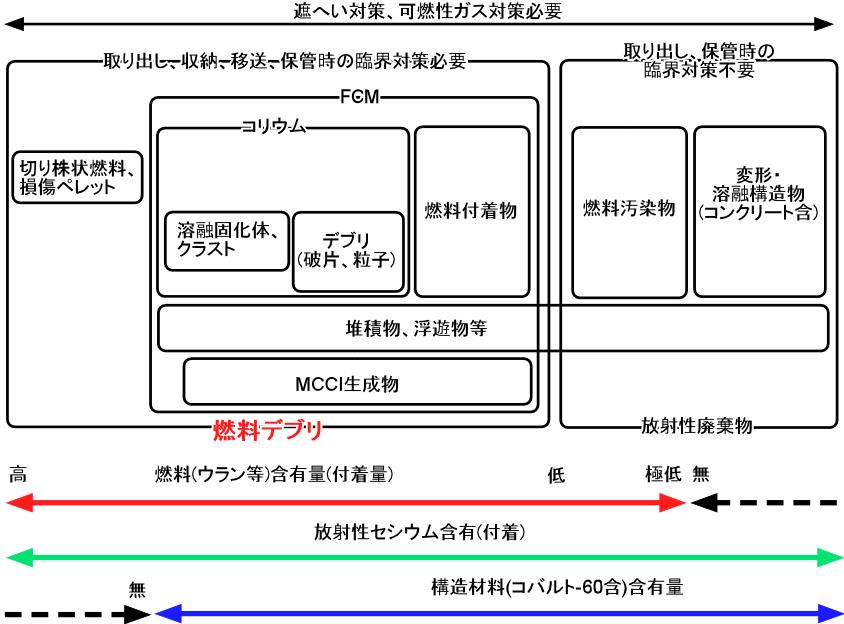Issue Number:FDR-201
Phase: Design
Decommissioning Process Fuel Debris Retrieval
Investigation Subject Sorting fuel debris
Issue Sorting fuel debris and radioactive waste
Needs
① Establishing a sorting method
Time Axis: Fuel Debris Retrieval [Short-Term]
Desired state and reasons for it
It is desirable to investigate the amount of material to be handled as fuel debris from a safe and rational point of view and to establish a method to sort fuel debris and radioactive waste in order to improve the estimation of the retrieval period and amount of material, and safety during storing.
In the Technology Strategic Plan, it is considered that the essence of fuel debris is the presence or absence of nuclear fuel materials. It is desirable to sort fuel debris based on the concentration of nuclear fuel materials.
In order to sort and distinguish fuel debris from radioactive waste, it is necessary to detect, sort, and quantify nuclides by retrieved material or by storage canister as accurately as possible and to measure (estimate) the nuclides and their concentration in nuclear fuel material.
Current state against ideal
For material retrieved from the PCV, it is important to determine whether it should be treated as fuel debris or radioactive waste, as early as possible through the process from retrieval to storing, even if the prior information is limited. However, there are no sorting standards nor methods.
Fuel debris contains a heterogeneous mixture of many nuclides and elements, including neutron absorbers, which may interfere with measurements, including voids. Therefore, the effects of the hindrance factors are evaluated by extensive simulation analysis for fuel debris of various possible compositions. Important points are planned to be confirmed by tests using existing test equipment. Based on these results, conceptual design of equipment and sorting scenarios are being studied.
The following chart shows an example of a concept of fuel debris to be retrieved in the Fukushima Daiichi NPS which experienced the accident.


Issues to be resolved
While there is a need to establish a nuclear material measurement technology for measuring (estimating) nuclides and their concentrations in nuclear fuel material, which can be applied to various types of material under high-dose condition, the results of the survey of candidate measurement technologies indicate that new technology development is needed due to the high degree of difficulty at this point in time. In particular, the problem is that there is no technology available to convert gamma and neutron radiation measurements, which are the main measurement targets, into uranium and plutonium quantities.
In addition, in the case of active neutron beam measurement, if there is a neutron absorber in the measurement, neutrons cannot be observed even if nuclear fuel material exists, and it may not be possible to identify the nuclear fuel material. Therefore, it is necessary to clarify the concept and perspective of sorting in the first place.
As a primary screening, in-situ analysis technology is required to confirm the presence or absence of fuel debris quickly. For example, it is desirable to determine whether or not a fuel component adhere to cut-out in-core structures, and if possible, the subsequent handling should be simplified.
For sorting, it is also important to investigate combining multiple technologies, and it is necessary to investigate sorting scenarios (e.g., multi-step sorting with in-situ analysis and analysis outside the building, etc.) and then investigate the necessary equipment and the process from retrieval to discharging. In addition, it is necessary to investigate establishing judgment criteria for sorting and setting target values for measurement performance.
Relevant Issues
References
- FDR-201 (PDF)
- Overall Diagram (HTML, PDF)
- Overall Diagram (Detailed Version) (PDF)
- Download all diagrams (diagram_en.zip, 9.4 MB)
- List of issues
Please note that this English text is a provisional translation of the Japanese original.